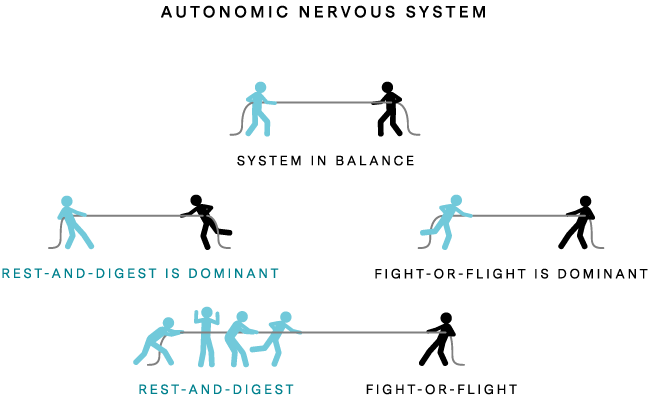When stressful thoughts consume your day, it can feel as though stress is strictly a mental problem. The reality is that stress materializes as both emotional and physiological symptoms—your brain and body are inseparable.
Whether you are running from a lion or preparing for a presentation at work, your brain and body share a single response system for all stressors—the autonomic nervous system (ANS).
Knowing how your body uses the ANS to react to different situations can help you build awareness and identify practices that transform your stress reaction into a reasoned response.
| Member Tip: Oura members can track their daily stress levels using the Daytime Stress feature. |
Stress vs. Rest
The ANS functions like a tug-of-war game between two subsystems: your activation (sympathetic nervous) system and your rest (parasympathetic nervous) system. Both regulate essential body functions like heart rate, respiratory rate, and digestion.
Your sympathetic nervous system is well known as the driver of your activating, fight-or-flight response, while the parasympathetic nervous system kicks in during calmer moments – like during periods of Restorative Time on Oura – as your rest-and-digest network.
Both systems dial their activity up or down based on messages from your brain and spinal cord. These systems can be active at the same time, or one can take over and dominate the other.

When activated, they trigger a cascade of changes in your body:
If your fight-or-flight system starts to dominate, there are some rest-and-digest functions that stop altogether, while others simply scale back.
Your rest-and-digest system has multiple players (e.g., your heart, lungs, liver). If your fight-or-flight system dominates, some parasympathetic players quit (e.g., digestion pauses while you’re running). Others may use a different tactic; for example, as you warm up for a jog, your body will shift its temperature-regulating strategy and reroute blood from your internal organs to your skin in an effort to shed heat.
| Fight-or-Flight (Sympathetic) | Rest-and-Digest (Parasympathetic) |
| Resting heart rate increases | Resting heart rate decreases |
| Heart rate variability (HRV) decreases | HRV increases |
| Respiration speeds up | Respiration slows |
| Blood flow increases to muscles and lungs | Blood flow increases to reprioritized digestive system |
| Blood flow decreases to deprioritized areas | Organs resume their day-to-day functions |
| Stress hormone levels rise | Stress hormone levels fall |
READ MORE: How Stress Affects Your Sleep
Finding Balance
Life’s stress levels naturally fluctuate. When your body remains in a stressed-out, fight-or-flight mode, it can take a serious toll on your health by slowing your recovery time, weakening your immune system, and impacting your mental state.
Our ANS was designed to help us deal with brief episodes of high-intensity stress (e.g., running from a predator), but our modern lifestyle contains multiple chronic stressors that rarely shut off (e.g., job pressure, balancing childcare and work, sleep deprivation, and constant device stimulation).
It’s all about balance. You don’t want your fight-or-flight system to be in a constant state of activation, but you also don’t want it to remain inactive—it is essential for your survival ability to respond to stress as well as maintain your body’s equilibrium.
LEARN MORE: HRV and Stress: What HRV Can Tell You About Your Mental Health
Managing Your Stress
We are often unaware of the tug-of-war inside our ANS because it functions involuntarily and reflexively. Becoming more in tune with the physiological effects of stress can help you regulate your response or deploy strategies to bring you back into balance.
Check out these tips to identify and reverse imbalances sooner:
- Become more self-aware: Techniques like meditation can help you become more in touch with how activated or relaxed your body is.
Member Tip: You can access guided meditations and breathing exercises under the Explore content on the Oura App. Taking a moment during the day also offers an opportunity to reset imbalances when you sense them and may even improve your sleep. - Sense imbalances sooner: Consider how wearables, like Oura, can give you the opportunity to follow patterns of stress within your body and measure their impact more objectively. By monitoring your HRV you can get an insight into how your ANS is doing. Use the Trends view to see how your HRV changes over time, or in response to certain life events.
- Improve your resilience: Increasing your fitness level and improving your sleep boosts your body’s ability to bounce back from stressful periods. If you’re looking for ways to rest and restore, consider these ideas.
RELATED: 9 Simple (and Science-Backed!) Ways to Lower Stress




